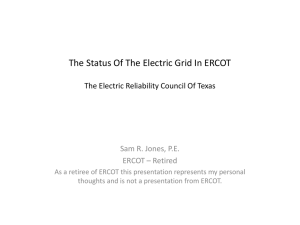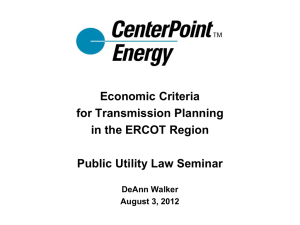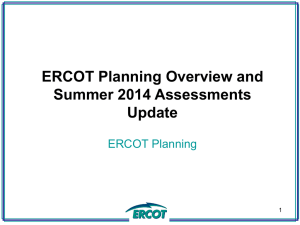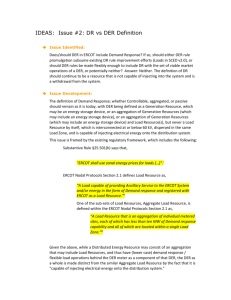042PGRR-04 NRG Comments 030215
advertisement
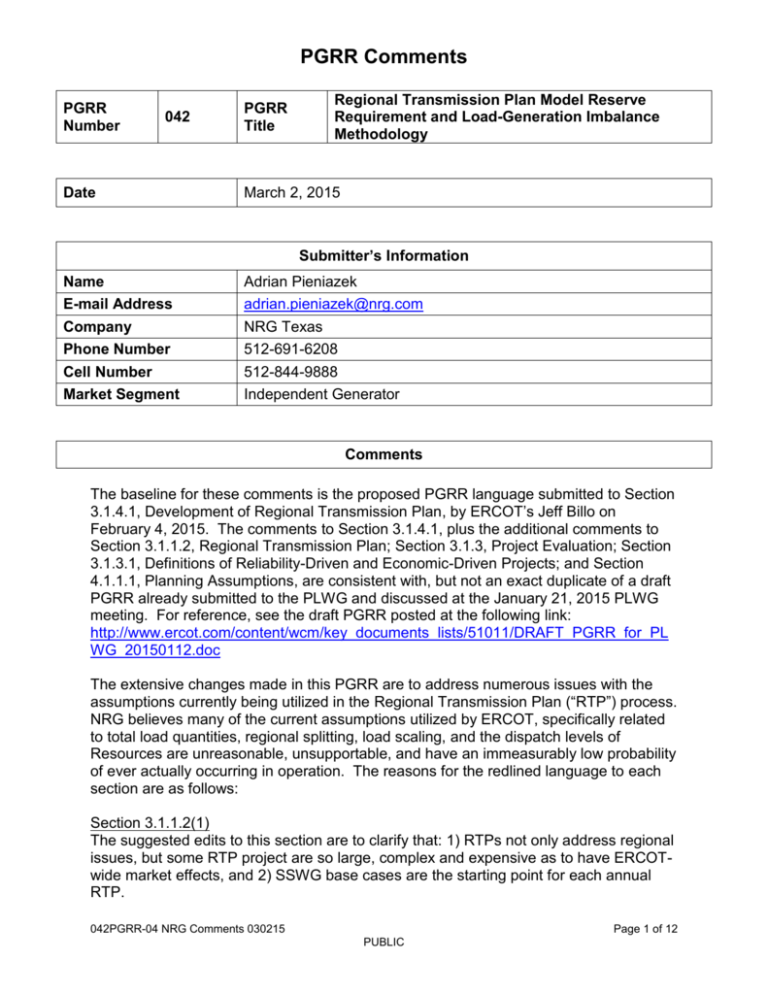
PGRR Comments PGRR Number 042 Date Regional Transmission Plan Model Reserve Requirement and Load-Generation Imbalance Methodology PGRR Title March 2, 2015 Submitter’s Information Name E-mail Address Adrian Pieniazek adrian.pieniazek@nrg.com Company NRG Texas Phone Number Cell Number Market Segment 512-691-6208 512-844-9888 Independent Generator Comments The baseline for these comments is the proposed PGRR language submitted to Section 3.1.4.1, Development of Regional Transmission Plan, by ERCOT’s Jeff Billo on February 4, 2015. The comments to Section 3.1.4.1, plus the additional comments to Section 3.1.1.2, Regional Transmission Plan; Section 3.1.3, Project Evaluation; Section 3.1.3.1, Definitions of Reliability-Driven and Economic-Driven Projects; and Section 4.1.1.1, Planning Assumptions, are consistent with, but not an exact duplicate of a draft PGRR already submitted to the PLWG and discussed at the January 21, 2015 PLWG meeting. For reference, see the draft PGRR posted at the following link: http://www.ercot.com/content/wcm/key_documents_lists/51011/DRAFT_PGRR_for_PL WG_20150112.doc The extensive changes made in this PGRR are to address numerous issues with the assumptions currently being utilized in the Regional Transmission Plan (“RTP”) process. NRG believes many of the current assumptions utilized by ERCOT, specifically related to total load quantities, regional splitting, load scaling, and the dispatch levels of Resources are unreasonable, unsupportable, and have an immeasurably low probability of ever actually occurring in operation. The reasons for the redlined language to each section are as follows: Section 3.1.1.2(1) The suggested edits to this section are to clarify that: 1) RTPs not only address regional issues, but some RTP project are so large, complex and expensive as to have ERCOTwide market effects, and 2) SSWG base cases are the starting point for each annual RTP. 042PGRR-04 NRG Comments 030215 Page 1 of 12 PUBLIC PGRR Comments Section 3.1.1.2(3)(a) This section includes a question for discussion at PLWG, as it is unclear what is meant by “normal system conditions,” especially with respect to the total load, regional coincident loads, and resource commitment and dispatch utilized in RTP studies. For example, the total load in previous RTP transmission planning studies has often been tens of thousands of MWs higher than ERCOT’s own peak load forecast. Sections 3.1.3 and 3.1.3.1 Language is proposed to acknowledge the importance of Load Resources in the ERCOT region. The Capacity, Demand and Reserves Report (“CDR”) fully recognizes the importance of Load Resources and includes them when calculating a reserve margin. In fact, Load Resources providing Responsive Reserve have been among the most reliable resources available to ERCOT operators for many years, and they receive the same ancillary service compensation as do Generation Resources providing the service. Nonetheless, Load Resources have heretofore been ignored in the annual RTP planning process. NRG believes it is not only inconsistent, but illogical as well, to recognize the critical reliability services provided by Load Resources in the CDR, yet ignore them completely when planning the transmission grid. Sections 3.1.4.1(4), (5), (6) and (7) The proposed edits to these sections are designed to bring consistency to the methodologies ERCOT utilizes when accounting for generation resources in transmission planning and when reporting resource adequacy in the CDR. For CDR purposes, all generation output levels for wind, solar, mothballs, RMRs, DC tie imports, and switchable units are clearly defined in Section 3.2.6.2.2 of the Protocols. Conversely, the output levels used in the RTP planning process have never been clearly delineated in either the Protocols or the Planning Guide. ERCOT has attempted to define the output levels in the RTP process via a non-binding “RTP Scope” document. However, previous planning studies show an inconsistent treatment of output levels for these generation resources, often with no underlying methodological explanation for the varying output. For example, a recently approved RTP project contained several sensitivity studies that contained vastly modified wind output levels among the various sensitivities. The sensitivity studies simply assumed the wind would change, as necessary, to help solve generation inadequacy issues in the cases. The levels of wind unit output had nothing to do with the probabilities that the wind levels would actually enable the levels of generation modeled during the peak load hour being analyzed. Therefore, the language in Sections 3.1.4.1(4), (5), (6) and (7) require transmission plans to utilize the same peak hour Resource output levels from the CDR, for all resource types, when performing transmission planning studies. Section 3.1.4.1(8) The PGRR042 comments submitted by ERCOT on February 4, 2015 included a provision that is a significant improvement to the current transmission planning process. ERCOT’s February 4th language stated “the total generation capacity in a Regional Transmission Plan base case before contingency outages will be greater than or equal 042PGRR-04 NRG Comments 030215 Page 2 of 12 PUBLIC PGRR Comments to the peak Load in the case plus losses plus a reserve of 2800 MW.” Surprisingly, many of the previous RTP projects, including some that have already been endorsed by the Regional Planning Group (“RPG”), TAC and the ERCOT Board, modeled the ERCOT system with only 1,375 MWs of reserves, which by definition results in an Energy Emergency Alert (“EEA”) condition requiring the implementation of load shedding procedures. Consequently, ERCOT planners have been starting the RTP study cases in a severely over-stressed condition. Compounding the problem, ERCOT also assumes every non-wind generator on the system (more than 500 of them) can run at 100% capacity during this peak, over-stressed condition - an assumption with an almost zero percent probability of actually occurring. A study case starting in a severely stressed EEA condition, with no extra generating resources available, guarantees that transmission violations will occur (many of them) which cannot be relieved by redispatch, thus leading to countless “reliability” issues that cannot be solved with the addition of transmission infrastructure. While ERCOT’s February 4th language is an important improvement to the RTP process, it is only one piece of the generation reserve equation. ERCOT’s language addresses only minimum “operating” reserves in the RTP studies. The RTP process ignores the “planning reserve margin” described in the protocols, even though there appears to be agreement among the PUCT, ERCOT Staff and all market participants that the ERCOT region will have a planning reserve margin in future years. While there may be disagreement as to how high or low the planning reserve margin will be, it is illogical and unreasonable to assume it will be zero. As evidence, the filings in PUCT Project 40000, Commission Proceeding to Ensure Resource Adequacy in Texas, includes an extremely detailed analysis by the Brattle Group that concludes today’s energy-only market design will likely achieve an 11.5% equilibrium reserve margin.1 Nonetheless, RTP study cases have assumed a planning reserve margin of ZERO, and in many cases the load in the studies was scaled down to prevent NEGATIVE reserve margins, an unrealistic and unsupportable assumption. The language included in these PGRR comments for Section 3.1.4.1(8) requires the RTP study cases to begin with enough Resources to meet the minimum planning reserve margin established in ERCOT Protocol Section 3.2.6.1, which is currently set at 13.75%. Since the RTP studies are peak studies, and the probability of all Resources being 100% available during peak conditions is extremely low and unrealistic, the proposed language suggests a deration of the generation resources based on their average forced outage rates during the summer season. However, all study cases shall maintain ERCOT’s recommended minimum operating reserve of 2,800 MWs. Section 3.1.4.1(9) and (10) The edits provided to these two sections are to ensure impartiality and consistency in the load forecasts used in the RTP, and to further recognize the important role Load Resources have in ensuring reliability. 1 Samuel A. Newell, et al., Estimating the Economically Optimal Reserve Margin in ERCOT, January 31, 2014. PUCT Project 40000, filing number 649. 042PGRR-04 NRG Comments 030215 Page 3 of 12 PUBLIC PGRR Comments Load Resources Section 3.1.4.1(9) includes a requirement that RTP study cases include Load Resources. As stated above in the comments to Sections 3.1.3 and 3.1.3.1, the CDR appropriately recognizes the importance of both Generation and Load Resources. Load Resources have proven their value time and again in the ERCOT market, and just like Generation Resources, Load Resources are compensated for the services they provide. There is, therefore, no logical reason to include Load Resources when calculating a generation reserve margin in the CDR, yet ignoring them when planning the transmission grid. The language added to Section 3.1.4.1(9) includes Load Resources in the RTP. The language also includes a deration variable XX%, if it can be shown that Load Resources should be derated in the RTP studies based on any available and confirmed statistical evidence. Load Forecasts For several years ERCOT has utilized a “higher of” methodology when choosing which load forecasts to use in the RTP study cases. The RTP studies select the weather zone load forecasts that are the higher of 1) ERCOT’s 90/10 extreme weather forecast, or 2) the aggregated weather zone forecasts provided by the TSPs in the SSWG cases. There are several issues with ERCOT’s current higher of methodology. For one, the SSWG forecasts are provided by the TSPs. NRG believes ERCOT’s decision to utilize the interested TSP’s SSWG load forecasts in the RTP (as long as they are higher than ERCOT’s 90/10 forecast) to justify the addition of new transmission infrastructure (and its requisite regulated rate of return), creates the appearance and risk of biased selfinterest, which undermines the integrity of the process and is not in the public’s best interest. It is akin to allowing generation entities to provide the load forecast for the CDR, which is obviously not part of the CDR process. Therefore, the language provided in Section 3.1.4.1(9) requires ERCOT to utilize their own, impartial weather zone load forecasts in the RTP instead of the SSWG forecasts provided by TSPs. Another critical problem with the current methodology is that each forecast, be it ERCOT’s or the TSPs, are non-coincident peak forecasts for each weather zone. Therefore, when choosing the higher of these non-coincident peak forecasts, and then summing up each one to calculate the total load in the study, it results in peak loads that are often over tens of thousands of MWs higher than ERCOT’s own coincident peak forecast for the study year. Consider the information in the table below from an ERCOT presentation to the RPG entitled “2014 RTP Inputs and Assumptions”, dated May 20, 2014. 042PGRR-04 NRG Comments 030215 Page 4 of 12 PUBLIC PGRR Comments The total loads in this table, which ERCOT transmission planners are using as a starting point for the 2014 RTP study cases, are unreasonably high when compared to ERCOT’s own peak forecasts for these same years. For example, the table above shows ERCOT will start any RTP transmission study for the year 2015 with a total load of 82,217 MWs. The most recent CDR shows a total peak load forecast in 2015 of 66,714 MWs, a difference of 15,503 MWs. If the ERCOT region were to actually experience peak loads this year anywhere near 82,217 MWs, then the ERCOT region will face huge load shedding events that cannot possibly be avoided, even with an unlimited level of transmission infrastructure. The 2014 RTP also predicts the year 2017 (2019 and 2020 as well) as potentially facing extreme load shedding events. ERCOT’s RTP will start with a total 2017 load of 85,351 MWs, while the CDR estimates the ERCOT region’s highest peak load will be 68,284 MWs, a difference of 17,067 MWs. When asked about these unreasonably high load forecasts in the RTP, ERCOT Staff has typically stated the forecasts are used to “stress the system.” NRG believes these unfathomable RTP load forecasts are more than just stressing the system. If they were to actually occur in operations they will likely collapse the system. It is imperative, for the sake of consumers in this state, that transmission infrastructure not be based on load levels that are completely out of the realm of possibility. These types of unsupportable RTP load assumptions lead to an overbuilt transmission grid that needlessly increases the already excessive transmission costs seen on today’s electric bills. The suggested language in Section 3.1.4.1(9) and (10) provides for the use of ERCOT’s extreme weather 90/10 load forecast as a starting point, thus allowing for a “stressed” system to be modeled, yet keeping the loads within the realm of possibility. The language also places an upper level boundary on the total load in the RTP studies to no higher than 3% above the peak firm load forecasted by ERCOT in the most recent CDR, thus bringing needed consistency between the load forecast used for resource adequacy reporting and transmission planning. Requiring the use of ERCOT’s load forecast, rather than the interested TSPs, will provide for an impartial, unbiased, and 042PGRR-04 NRG Comments 030215 Page 5 of 12 PUBLIC PGRR Comments more realistic starting point for the RTP. And as discussed previously, the inclusion of Load Resources in the RTP study cases is warranted, reasonable, and long overdue. Section 3.1.4.1(11) and (12) The final edits to Section 3.1.4.1 describe the process to be used if and when there is a shortage of generation in an RTP study case once all the steps in 3.1.4.1(1) through (10) have been followed. In recent years, the RTP studies have been modified due to a severe shortage of generation resources in the model. The two reasons for the generation shortages, excessive load forecasts and no planning reserve margin, were discussed previously. To handle the generation shortage issue, a methodology of splitting the ERCOT region into separate study areas and then “scaling”, or reducing, the load outside a study area has been implemented by ERCOT transmission planners. ERCOT described load scaling as follows in a recently approved RTP project: “In transmission planning analysis the amount of generation available in the base case may not be enough to meet the summed non-coincident peak load of all areas of the system. In order to solve this challenge… ERCOT split the 2018 summer peak case into two study areas…. For each study area the load level was set to the forecasted peak load for that area while load outside of the area was scaled down until there was enough generation to meet the load plus an operational reserve of approximately 1,375 MW.” Regional Splits Market participants and ERCOT Staff have discussed the process of splitting the ERCOT region into two separate study regions, as described above, during numerous RPG and PLWG meetings. The primary problem with splitting the state into only two study regions is that it is not granular enough to account for the differences in coincident peak loads across all eight weather zones. Splitting the state into multiple regions, eight for example to match the number of weather zones, results in a large increase in the number of studies that must be performed during the annual RTP process. Therefore, to balance the need for more granularity, while keeping the number of studies to a manageable level, the language proposed in Section 3.1.4.1(11)(a) requires that there never be less than four study regions in any annual RTP. Load Scaling Neither the Protocols nor the Planning Guide contain any language authorizing the use of load scaling, and consequently they provide no guidance on the quantity of scaling that might be considered reasonable. Load scaling, if used as a planning tool, must be used judiciously and in a reasonable, defensible manner because it is a back-door assumption for adding phantom generation to a planning case. With ERCOT’s current methodology, the load is reduced at the load buses only in the areas outside the study region. That procedure is electrically equivalent to adding distributed generation at only those load buses, an assumption that is unreasonable and devoid of any statistical or analytical basis. Since ERCOT has acknowledged that regional splits and load scaling are used to solve generation shortages in the models, one may ask how the building of new transmission infrastructure solves the generation shortage? The answer is it doesn’t. It is therefore 042PGRR-04 NRG Comments 030215 Page 6 of 12 PUBLIC PGRR Comments extremely important that load scaling be limited in use, and if used it should be based on a statistically valid and reasonable methodology. Otherwise, an RTP study case will have transmission load flows that are significantly modified depending on the location and magnitude of the scaling, providing false transmission line loading values, while masking the true underlying issue, a shortage of generation. The language provided in 3.1.4.1(11) places limits on the amount of load scaling that can be used in a study case, basing the limits on a rolling 5 year average of the scaled weather zone’s peak load coincidence with the study area’s peak load. This will at least limit the scaling to a statistically derived and supportable quantity, instead of the current process of unlimited load scaling until there is enough generation to meet the modified total load and the reserve requirements. Section 3.1.4.1(12) defines a final procedure to use if all of the preceding steps still lead to a shortage of generation in an RTP study case. The language allows for the addition of new generation to the study case and is derived from the SSWG Procedure Manual, Section 4.3.3.1, Extraordinary Dispatch Conditions, which has been approved by the Reliability and Operations Subcommittee. It is NRG’s opinion that if the total load and generation in an RTP study case are modeled at reasonable levels as described herein, and if regional splitting and load scaling are performed as defined above, then the extraordinary dispatch procedures in Section 3.1.4.1(12), which are based on the SSWG procedure, will rarely, if ever, be required. Nonetheless, NRG includes the language in this section if and when an RTP study case does not have enough generation to meet the total load and reserve requirements. Section 4.1.1.1, Planning Assumptions The edits to this section are included to refer the planner to the Section 3 language, included in these PGRR comments, that will now contain a detailed description of the assumptions that will be utilized in an RTP transmission planning study. Revised Cover Page Language Planning Guide Sections Requiring Revision 3.1.1.2, Regional Transmission Plan 3.1.3, Project Evaluation 3.1.3.1, Definitions of Reliability-Driven and Economic-Driven Projects 3.1.4.1, Development of Regional Transmission Plan 4.1.1.1, Planning Assumptions Revised Proposed Guide Language 3.1.1.2 (1) Regional Transmission Plan The Regional Transmission Plan is developed annually by ERCOT, in coordination with the RPG and Transmission Service Providers (TSPs). The Regional Transmission Plan addresses regional and ERCOT-wide reliability and economic transmission needs and the 042PGRR-04 NRG Comments 030215 Page 7 of 12 PUBLIC PGRR Comments planned improvements to meet those needs for the upcoming six years starting with the SSWG base cases. These planned improvements include projects previously approved by the ERCOT Board, projects previously reviewed by the RPG, new projects that will be refined at the appropriate time by TSPs in order to complete RPG review, and the local projects currently planned by TSPs. Combined, these projects represent ERCOT’s plan which addresses the reliability and efficiency of the ERCOT System in order to meet North American Electric Reliability Corporation (NERC) Reliability Standards, the Protocols, Operating Guides and this Planning Guide. Projects that are included in the Regional Transmission Plan are not considered to have been endorsed by ERCOT until they have undergone the appropriate level of RPG Project Review as outlined in Protocol Section 3.11.4, Regional Planning Group Project Review Process, if required. The process used by ERCOT to develop the Regional Transmission Plan is outlined in Section 3.1.4, Regional Transmission Plan Development Process. (2) ERCOT shall post the Regional Transmission Plan to the Market Information System (MIS) Secure Area by December 31 of each year. (3) ERCOT shall include in the Regional Transmission Plan report a list of Transmission Facilities that are loaded above 95% of their applicable Ratings for the following conditions: 3.1.3 (a) Normal system conditions; or (b) Following the contingency loss of a single generating unit, transmission circuit, transformer, or common tower outage. Project Evaluation (1) Proposed transmission projects will be evaluated using a variety of tools and techniques to ensure that the system is able to meet applicable reliability criteria in a cost-effective manner. For most proposed projects, several alternatives will be identified to meet the reliability criteria or other performance improvement objectives that the proposed project is designed to meet. The project alternative with the expected lowest cost over the life of the project is generally recommended, subject to consideration of the expected long-term system needs in the area (as identified in the LTSA), and consideration of the relative operational impacts of the alternatives. The consideration of potential generation and/or load resource alternatives may also be included in the evaluation of Tier 1, 2 and 3 projects due to the potentially large consumer costs of these projects. (2) In some cases, one alternative may be to dispatch the system in such a way that all reliability requirements are met, even without the proposed transmission project or any transmission alternative, resulting in a less efficient dispatch than what would be required to meet the reliability requirements if the proposed project was in place. Consideration of the merits of this alternative relative to the proposed transmission project is more complex. To facilitate the discussion and consideration of these alternatives, ERCOT has adopted certain definitions and practices, described in paragraph (4) of Protocol Section 042PGRR-04 NRG Comments 030215 Page 8 of 12 PUBLIC PGRR Comments 3.11.2, Planning Criteria, and Sections 3.1.3.1, Definitions of Reliability-Driven and Economic-Driven Projects, and 3.1.3.2, Reliability-Driven Project Evaluation below. 3.1.3.1 (1) (2) 3.1.4.1 Definitions of Reliability-Driven and Economic-Driven Projects Proposed transmission projects are categorized for evaluation purposes into two types: (a) Reliability-driven projects; and (b) Economic-driven projects. The differentiation between these two types of projects is based on whether a simultaneously-feasible, security-constrained generating unit commitment and Load Resource dispatch is expected to be available for all hours of the planning horizon that can resolve the system reliability issue that the proposed project is intended to resolve. If it is not possible to forecast a dispatch of the Resources such that all reliability criteria are met without the project, and the addition of the project allows the reliability criteria to be met, then the project is classified as a reliability-driven project. If it is possible to simulate a dispatch of the Resources in such a way that all reliability criteria are met without the project, but the project may allow the reliability criteria to be met at a lower total cost, then the project is classified as an economic-driven project. Development of Regional Transmission Plan (1) The starting base cases for the Regional Transmission Plan development are created by removing all Tier 1, 2 and 3 projects that have not undergone RPG Project Review from the most recent SSWG summer peak base cases to address the planning horizon. The planning process begins with computer modeling studies of the generation and Transmission Facilities and substation Loads under normal conditions in the ERCOT System. Contingency conditions along with changes in Load and generation that might be expected to occur in operation of the ERCOT Transmission Grid are also modeled. To maintain adequate service and minimize interruptions during Outages, model simulations are used to identify adverse results based upon the planning criteria and to examine the effectiveness of various problem-solving alternatives. (2) The effectiveness of each alternative will be evaluated under a variety of possible operating environments because Loads and operating conditions cannot be predicted with certainty. As a result, repeated simulations under different conditions are often required. In addition, options considered for future installation may affect other alternatives so that several different combinations must be evaluated, thereby multiplying the number of simulations required. (3) Once feasible alternatives have been identified, the process is continued with a comparison of those alternatives. To determine the most favorable, the short-range and 042PGRR-04 NRG Comments 030215 Page 9 of 12 PUBLIC PGRR Comments long-range benefits of each must be considered including operating flexibility and compatibility with future plans. (4) For Regional Transmission Plan analysis, all existing generation plants are retained from the SSWG start cases. The ERCOT Generation Interconnection Status (GIS) database will be used as a reference list containing the status of future generation. Generation identified as retired in the current CDR will be modeled as offline for appropriate cases. (5) In the reliability-driven projects, the DC ties and hydro, wind, and solar units will be dispatched to the levels described in Protocol Section 3.2.6.2.2, Total Capacity Estimate. (6) For economic-driven projects, an 8,760-hour profile will be used for hydro, wind, and solar units. AWS Truepower profiles will be used for wind, URS solar curves will be used for solar, and average historical dispatch during the summer season for the past 3 years will be used to create the hydro unit and DC tie profiles. (7) Per ERCOT Protocol Section 16.5.4, Maintaining and Updating Resource Entity Information, and upon receipt of a written notice, Switchable Generation Resource parameters used in the Regional Transmission Plan cases, whether they are reliabilitydriven or economic-driven projects, will be updated to appropriately reflect the amount of switchable generation available to ERCOT for the study cases. (8) Reliability-driven and economic-driven analyses will be performed using the minimum planning reserve margin established by ERCOT Protocol Section 3.2.6.1, Minimum ERCOT Planning Reserve Margin Criterion. The generation resources in each study case shall be derated by an amount equal to the average forced outage rate by technology type, calculated for the past 3 years during the summer season. After derating the generating units, the operating reserve requirement in the Regional Transmission Plan cases shall never be less than 2,800 MW. (9) The load utilized in the Regional Transmission Plan cases shall be organized and evaluated by weather zones. ERCOT’s 90th percentile weather zone peak load forecast, plus self-serve load, for the study year shall be used for each weather zone. XX% of the Load Resources providing Responsive and Non-Spinning Reserve service, as calculated in Protocol Section 3.2.6.2.2, Total Capacity Estimate, shall be subtracted from the appropriate weather zone load forecasts. XX% of the Emergency Response Service, Controllable Load Resources, and Energy Efficiency, as calculated in Protocol Section 3.2.6.2.2, Total Capacity Estimate, shall be subtracted from the appropriate weather zone load forecasts. (10) The total load in the study cases shall be no more than 3% higher than the total firm peak load forecasted by ERCOT in the most recent Capacity, Demand and Reserves (“CDR”) report. If the total load in the RTP case is greater than 3% higher than the CDR firm peak load forecast, then each weather zone load shall be reduced by equal percentages until the 042PGRR-04 NRG Comments 030215 Page 10 of 12 PUBLIC PGRR Comments total load is less than 3% above the CDR forecast. The ERCOT 50th percentile load forecast, plus self-serve load, will be used for the economic portion of the analysis. (11) If there are not sufficient generation resources, as adjusted for the average forced outage rates described above, to meet the load, loss, and reserves described above, the following methods may be used. (a) The base case may be split into multiple study regions, but in no case shall the number of study regions be less than four. A study region may be a combination of multiple weather zones, such that the load inside the study region remains at the level determined as per paragraph 10 above. (b) (12) 4.1.1.1 (1) Load outside the study region may be reduced until the load, loss, and reserve requirements are met. The load scaling reductions outside the study region shall not be greater than the percentage of the weather zone’s non-coincident peak when the study region is at its peak, based on a running 5-year average of percentages. If after scaling there is still not enough generation to meet the load, loss, and reserve requirements, the following resources shall be added to the cases until the reserves are met: (a) DC Ties dispatched to their full capacity to increase energy transfers into ERCOT, (b) Increase NOIE generation with the NOIE’s prior consent, (c) Add mothballed units that have not yet announced their return to service during the study period, (d) Dispatch units that are solely contracted for Black Start Service, (e) Add resources with interconnection agreements and air permits but have not yet met financial security requirements. (f) Add resources with interconnection agreements but have not yet received air permits and have yet to acquire water rights. (g) The wind generation output level for generators outside the study region may be increased to a higher value. However, this level should not exceed the 25th percentile output from the AWS Truepower profiles sampled for hours when ERCOT load is higher than the 90th percentile. Planning Assumptions A contingency loss of an element includes the loss of an element with or without a single line-to-ground or three-phase fault. 042PGRR-04 NRG Comments 030215 Page 11 of 12 PUBLIC PGRR Comments (2) A common tower outage is the contingency loss of a double-circuit transmission line consisting of two circuits sharing a tower for 0.5 miles or greater. (3) Unavailability of a single generating unit includes an entire Combined Cycle Train, if no part of the train can operate with one of the units Off-Line as provided in the Resource Registration data. (4) The contingency loss of a single generating unit shall include the loss of an entire Combined Cycle Train, if that is the expected consequence. (5) For Regional Transmission Plan studies, the planning assumptions that may be applied to the SSWG base cases are described in Section 3.1.4.1, Development of Regional Transmission Plan. 042PGRR-04 NRG Comments 030215 Page 12 of 12 PUBLIC


